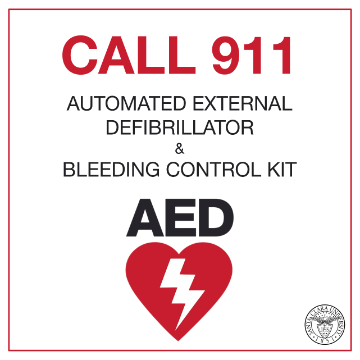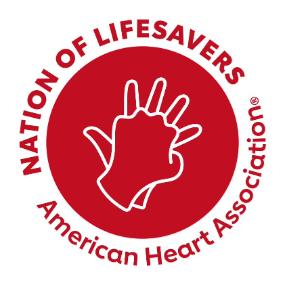For cardiac-related emergencies, There over 60 Automated External Defibrillators (AEDs) placed throughout the main campus.
The 2 models of AEDs that are currently placed across campus for public use:

View a demo of the LIFEPAK CR2: Hands Only CPR with cprINSIGHT*

View a demo of the LIFEPAK CR Plus AED
Proper AED use is part of the AHA Out-of-hospital Chain of Survival that can improve chances of survival and recovery for victims of cardiac arrest.
*cprINSIGHT analysis technology
Bleeding Control / Individual Response Kits
Most AED Cabinets on campus contain Bleeding Control Kits. Each kit provides "non-traditional" lay responders a compact kit with the means and ability to stop life-threatening bleeding and provide basic, potentially life-saving care prior to the arrival of professional rescuers. Look for the "Bleeding Control Kit" decal shown below on the exterior of the AED cabinet.
Please remember, the Bleeding Control Kits are NOT to be used for minor cuts, scrapes, or other injuries where no traumatic, or uncontrolled bleeding is occurring. For minor injuries, you may use the contents from a nearby First Aid Kit, or call Campus Safety at 408-554-4441.

These kits include the following:
- 1 SWAT-T Tourniquet
- 1 Pair Nitrile Gloves
- 1 CPR Face Shield
- 2 ABD Pads, 5" x 9"
- 2 Rolled Gauze, 3" x 5yds
- 1 Triangular Bandage w/ 2 Safety Pins, 40" x 40" x 56"
- 1 Mini-Sharpie
- 1 Casualty Card
- 2 Resealable Bags
- 1 Rescue Blanket
- 1 Trauma Shears, 5.5"
- 1 Medic Reinforcement Tape, 2" x 100yds
- 1 Immediate Action Card
- 1 Safety Pin, 1.5"
For more information on AEDs, visit the University's AED FAQ.
For more information on Bleeding Control, visit the STOP THE BLEED® website, and view the "Save a life" flowchart.
A growing number of SCU campus community members have been trained in CPR and AED use. Please note that AEDs located inside certain buildings may not be publicly accessible outside of normal business hours. Learn more about AEDs from University Operations. Off-campus SCU AEDs are located at 1030 The Alameda and 1735 Leroy, Berkeley. The University conducts monthly checks of all installed AEDs.
No CPR Training? Hands Only CPR
Cardiac arrest – an electrical malfunction in the heart that causes an irregular heartbeat (arrhythmia) and disrupts the flow of blood to the brain, lungs and other organs – is a leading cause of death. Each year, more than 350,000 EMS-assessed outof-hospital cardiac arrests occur in the United States.
When a person has a cardiac arrest, survival depends on immediately receiving CPR from someone nearby.
Hands-Only CPR has been shown to be as effective in the first few minutes as conventional CPR for cardiac arrest at home, at work or in public. Hands-Only CPR has just two easy steps, performed in this order:

Student/Staff/Faculty CPR and AED Training: If you would like to practice Hands Only CPR, please contact Tyler Masamori at tmasamori@scu.edu to schedule a 1:1, or small group session (limit 6 persons per session).

The Santa Clara Fire Department provides Medical Emergency information to a powerful app called PulsePoint Respond. This app "empowers everyday citizens to provide life‐saving assistance to victims of sudden cardiac arrest."
Further, "App users who have indicated they are trained in cardiopulmonary resuscitation (CPR) and willing to assist in case of an emergency can be notified if someone nearby is having a cardiac emergency and may require CPR.
If the cardiac emergency is in a public place, the location-aware application will alert users in the vicinity of the need for CPR simultaneous with the dispatch of advanced medical care. The application also directs these potential rescuers to the exact location of the closest Automated External Defibrillator (AED)."
Download the app for iOS or Android HERE.
Automatic External Defibrillators should only be used in a situation when someone is unconscious, not breathing and does not have a pulse, and in conjunction with CPR.
If there is ever any doubt if the person has a pulse or is breathing, continue attaching the AED as instructed. The device will analyze the heart rhythm and determine the next steps for the user to follow.

All AEDs on campus are equipped with easy to follow voice instructions that start when the AED lid is opened. The AED will begin to analyze the patient when the AED pads are attached to them.
View this video showing how to use a LIFEPAK CR2: Using a semi-automatic AED on an adult.
Note, the CR2 model AEDs (white) will give Hands Only CPR instructions.
If you are in a situation on campus where someone does not have a pulse or is not breathing, please follow these steps:
- Call or text 911, then call Campus Safety at 408-554-4444.
- Remove the AED from the wall cabinet (a local alarm may sound).
- Open the AED and follow the voice prompts.
- For the CR2 AEDs, you may select English or Spanish, then a Child mode if applicable.
- Begin or continue to administer CPR when the AED instructs you.